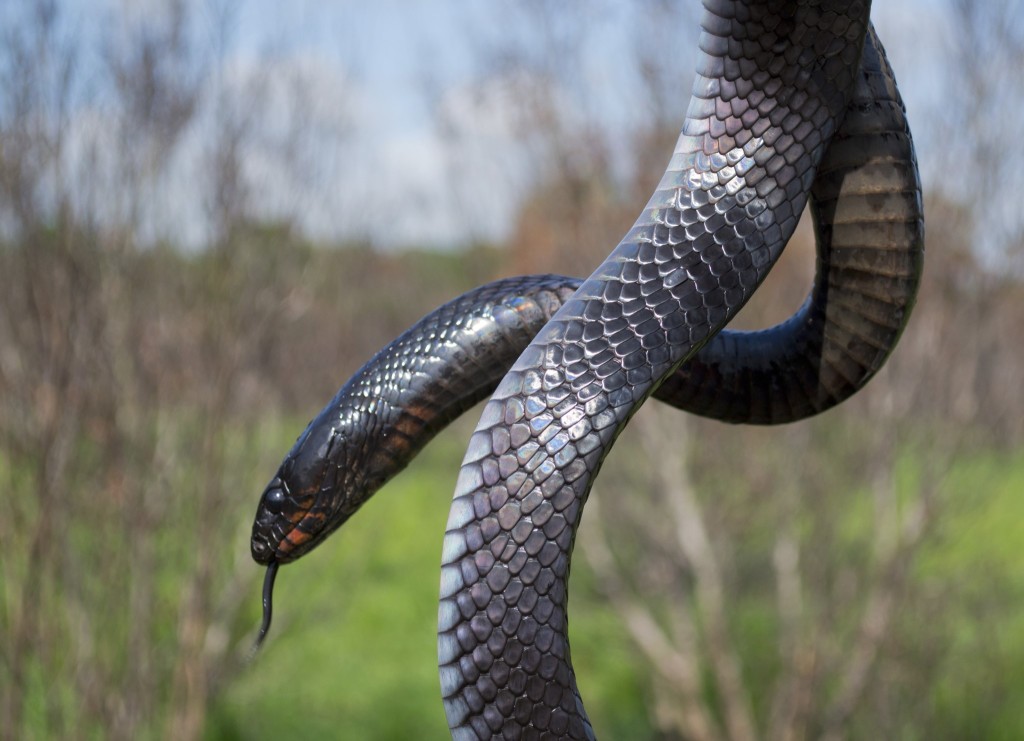
Author: Jack Christie
“Driving through the Florida scrub at Archbold one afternoon, my thoughts were elsewhere,” recounts Archbold Herpetology Program research intern Jack Christie. “Though they snapped right back to the present when I saw the long shape of a snake stretching across the road in front of me. There was something unusual about this one. As I got closer, the snake sensed my presence and turned back the other way, returning to the thick vegetation. I jumped out of the vehicle and caught up with it. Surrounded by the buzz of insects and the hot Florida air, a six-foot long Eastern Indigo Snake looked back at me, waiting to see what would happen next.”
“I couldn’t believe how lucky I was,” said Jack. He has some good reasons to be excited. Adult indigo snakes can grow up to more than eight feet in length, making them the longest native species of snake in North America. Indigos get their name from their iridescent black scales, and often have coral to crimson coloration on their chin, making them beautiful to behold. “They lead exciting lives, too,” explains Jack. “They travel long distances while foraging and seeking mates, and they’ll eat just about anything. Humans however, have nothing to fear. Indigo snakes aren’t venomous and have a reputation for being gentle.”
Much of the pioneering indigo snake research was conducted here in Highlands County by the first Archbold Director of Research, Dr. Jim Layne, and his research is still influential today. The Archbold Herpetology Program continues to document sightings and collect data from the few individuals we find each year. “When we started to measure the snake back at the lab, we found something interesting,” says Jack. “We found a large bulge in the middle of its body– indicating the snake had eaten recently. They’ll eat just about anything they can swallow, including rodents, birds, frogs, and even young Gopher Tortoises and other snakes.” Indigo snakes play a vital role in the ecosystem as an apex predator. Their flexibility in diet is important too. For example, if there were fewer frogs one year, they might be able to eat more mice instead, helping bring balance to the ecosystem they’re a part of.
Their movements are just as wide-ranging as their diet. Indigos make some of the longest movements of any snake, crossing through a variety of habitat types. They need large swathes of land, with especially wayfaring individuals using over 1000 acres in a single year, according to scientific studies done here in Highlands County. All this moving takes them across roads and other man-made structures, putting them at risk of being hit by cars or being killed by fearful humans. Highlands County has some of the most intact indigo habitat left in Florida. To protect indigo snakes means protecting where they live, and the ecosystem that they’re a part of.
“After we finished collecting data on the indigo snake, we release her back into the scrub,” said Jack. As Jack watched the snake disappear back into the thick brush, one thing became clear; while the scrub may have abided a few hours without its resident hunter, it would be a less resilient, less special place if they were to disappear for good. To learn more about the Archbold Herpetology Program, please visit our website: https://www.archbold-station.org/html/research/herpetology/herpetol.html

